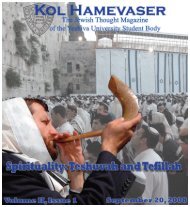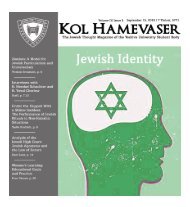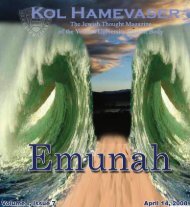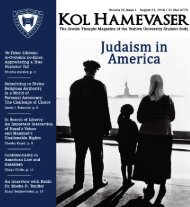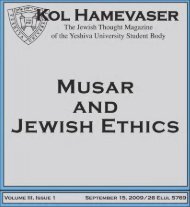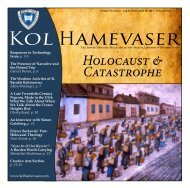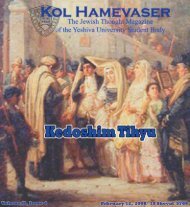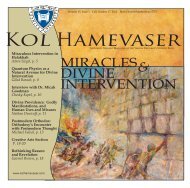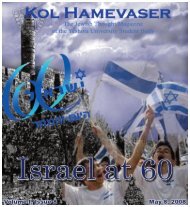You also want an ePaper? Increase the reach of your titles
YUMPU automatically turns print PDFs into web optimized ePapers that Google loves.
powers are inaccessible <strong>and</strong> incomprehensible<br />
to the vast majority of Jews.<br />
However, the great physicist <strong>and</strong> Kabbalist<br />
R. Aryeh Kaplan, zts”l, outlines two other<br />
forms of Jewish mysticism that can be practiced<br />
<strong>and</strong> studied by all Jews, especially<br />
through Hasidut. xxix These two categories are<br />
“meditative Kabbalah” <strong>and</strong> “theoretical Kabbalah,”<br />
both of which are extensively discussed<br />
in many major Kabbalistic works,<br />
including the Zohar. Meditative Kabbalah, accomplished<br />
through hitbodedut (reflective isolation)<br />
<strong>and</strong> hitbonenut (meditation), allows a<br />
person to quiet his mind <strong>and</strong> achieve a direct<br />
experience of God, which is a major part of<br />
Hasidut. Theoretical Kabbalah contains the<br />
“mechanics of the divine realm,” explaining<br />
the other branches of Kabbalah <strong>and</strong> providing<br />
an underlying philosophy of Judaism. xxx<br />
Perhaps the most fundamental reason for<br />
the rejection of Kabbalah by many Jews today<br />
is that they see rationalism <strong>and</strong> mysticism as<br />
antithetical schools of thought. This seems to<br />
be especially so for Modern Orthodox Ashkenazim,<br />
a community that does not seem able to<br />
shake its philosophically-outdated Enlightenment<br />
insecurity about the non-rational elements<br />
of Jewish tradition. Ironically, this<br />
anxiety creates strange double st<strong>and</strong>ards within<br />
Modern Orthodoxy; for instance, the Zohar has<br />
been dated to the 13 th century using the same<br />
academic methods by which scholars date all<br />
of Jewish Oral Law to the post-Second Temple<br />
period. Yet, many Jews who claim that the<br />
Zohar is late would never consider doing so<br />
with regard to the Talmud.<br />
In truth, though, it may be that the question<br />
of rationality is itself irrelevant. “The mystic,<br />
the halachist, as well as the pure scientist<br />
live in an ideal world. Given their own criteria,<br />
the structures are perfectly logical in themselves.”<br />
xxxi I have long heard the silly argument,<br />
“It is not scientific,” as if science ever<br />
claimed to underst<strong>and</strong> reality in its totality, as<br />
if the spirit of man is governed by scientific<br />
canons. Even the atheist believes: he believes<br />
that the sun will rise tomorrow or that the traffic<br />
light will change to green, though he has no<br />
purely rational grounds for doing so. Do pure<br />
rationalists “circumscribe themselves ‘scientifically’<br />
in anything but their refusal to be men<br />
in the fullest sense of the word”? xxxii<br />
Instead of putting them in conflict, Judaism<br />
teaches that mysticism <strong>and</strong> rationality<br />
should play complementary roles as two distinct<br />
ways of approaching existence that are<br />
<strong>Halakhah</strong> <strong>and</strong> <strong>Minhag</strong><br />
both divine <strong>and</strong> not mutually exclusive. Rationality<br />
allows one to cognize reality <strong>and</strong> develop<br />
ways of relating to <strong>and</strong> measuring it –<br />
asiyyat ha-mitsvah – while mysticism gives<br />
one the ability to experience reality directly,<br />
kavvanat ha-mitsvah. We were given comm<strong>and</strong>ments<br />
by God <strong>and</strong> an intellect to decipher<br />
those comm<strong>and</strong>ments <strong>and</strong> determine how to<br />
carry them out <strong>and</strong> apply them to our lives.<br />
However, without at least a basic awareness<br />
that one is performing a comm<strong>and</strong>ment of<br />
God, one does not fulfill his or her<br />
obligation. xxxiii This awareness is the simplest<br />
level of mysticism needed for one to fulfill his<br />
halakhic obligations. The more we intuitively<br />
underst<strong>and</strong> the nature of existence <strong>and</strong> our<br />
place in it, the closer we come to a union with<br />
God, for “God knows the world as the truth of<br />
His own existence” <strong>and</strong> thus “man <strong>and</strong> God are<br />
united in knowledge of the world.” xxxiv However,<br />
what makes this mystical union Jewish is<br />
the underst<strong>and</strong>ing that “knowledge without action<br />
serves no purpose.” xxxv We express this<br />
union in concrete acts <strong>and</strong> halakhic behaviors<br />
that emphasize individuality rather than nullify<br />
it.<br />
Whatever the explanation may be for our<br />
neglect of our mystical tradition, the fact is that<br />
“Instead of putting them in conflict,<br />
Judaism teaches that mysticism <strong>and</strong><br />
rationality should play complementary<br />
roles as two distinct ways of<br />
approaching existence that are both<br />
divine <strong>and</strong> not mutually exclusive.”<br />
many Jews are being lost in the legalism of<br />
today’s Judaism. Jewish youth are spiritually<br />
starved <strong>and</strong> seek to quench their thirst for<br />
meaning with Buddhism, Hinduism, or music.<br />
We have gone so far in denying <strong>and</strong> burying<br />
Kabbalah that Judaism is the last place where<br />
some Jews look for spirituality, further boosting<br />
ever-rising assimilation rates. In addition,<br />
due to the neglect of Jewish mysticism in traditional<br />
circles, Kabbalah has sadly become<br />
the domain of Madonna <strong>and</strong> the Los Angeles<br />
Kabbalah Center. I once heard someone say<br />
that Judaism gave away the L<strong>and</strong> of Israel to<br />
the secular Zionists, Hebrew to the Maskilim,<br />
<strong>and</strong> Tanakh to the Christians. Now, we are<br />
ab<strong>and</strong>oning our ancient spiritual tradition to<br />
Hollywood.<br />
It is time that modern Judaism face Torat<br />
ha-Sod rather than ignore it or flee from it.<br />
Even many scholars of the 20 th century, including<br />
Scholem, acknowledge the enriching impact<br />
that Kabbalah has had on Jewish<br />
existence, strengthening the inner life of the individual<br />
Jew <strong>and</strong> Jewry as a whole with its<br />
wealth of symbolism <strong>and</strong> imagery. xxxvi Kabbalah,<br />
our tradition, is essential for our spiritual<br />
redemption <strong>and</strong> the emergence of a united<br />
society in perfect harmony with the Eyber-<br />
shter, God, the Eternal One, existence itself. As<br />
Rav Kook, zts”l, writes:<br />
“Due to the alienation from the ‘secret of<br />
God’ [Hidden Torah], the higher qualities<br />
of the depths of godly life are reduced to<br />
trivia that do not penetrate the depth of the<br />
soul. When this happens, the most mighty<br />
force is missing from the soul of the nation<br />
<strong>and</strong> individual [...] We should not<br />
negate any conception based on rectitude<br />
<strong>and</strong> awe of Heaven of any form – only the<br />
aspect of such an approach that desires to<br />
negate the mysteries <strong>and</strong> their great influence<br />
on the spirit of the nation. This is a<br />
tragedy that we must combat with counsel<br />
<strong>and</strong> underst<strong>and</strong>ing, with holiness <strong>and</strong><br />
courage.” xxxvii<br />
We should all merit to witness the day<br />
when we realize the fullest expression of our<br />
ancient tradition <strong>and</strong> incorporate every dimension<br />
of our humanity as both rational <strong>and</strong> spiritual<br />
beings.<br />
Periel Shapiro is a junior at YC majoring<br />
in History.<br />
i Hoshea 2:21-22, <strong>and</strong> Yirmeyahu 31:21<br />
ii Gershom Scholem, Kabbalah (New York:<br />
Quadrangle/New York Times Book Co., 1974),<br />
p. 196.<br />
iii See, for example, in regards to the laws of<br />
washing h<strong>and</strong>s, where the Zohar is cited three<br />
times (Shulhan Arukh, Orah Hayyim 4:8-9,<br />
4:16).<br />
iv Mishnah Berurah 1:1-4; see also Din Kavvanat<br />
ha-Berakhot (siman 5), where R. Karo’s<br />
wording has clear mystical intimations that are<br />
discussed explicitly by Gra <strong>and</strong> the Hafets<br />
Hayyim.<br />
v Based on: http://www.britannica.com/<br />
EBchecked/topic/312602/Joseph-ben-<br />
Ephraim-Karo. R. Karo’s mystical diary, the<br />
Maggid Meisharim, which recorded the nocturnal<br />
visits of an angelic being over the course<br />
of fifty years, was likely never intended for<br />
publication.<br />
vi R. Karo’s pupil was R. Moshe ben Ya’akov<br />
Cordovero, the leading Jewish mystic in Safed,<br />
whose disciples included prominent Safed<br />
Kabbalists like R. Eliyyahu de Vidas, the author<br />
of the Reshit Hokhmah, as well as R.<br />
Hayyim Vital.<br />
vii Scholem, p. 1.<br />
viii Ibid., p. 8.<br />
ix Ibid., p. 10.<br />
x Ibid., p. 22.<br />
xi Ibid., p. 10.<br />
xii Avot 1:1. Pirkei Avot is popularly known as<br />
“Ethics of the Fathers,” but it is probably better<br />
translated as “Chapters of Fundamental Principles,”<br />
considering that the Talmudic usage of<br />
the term “avot” often refers to principle categories.<br />
After all, these chapters are the defining<br />
principles of the Torah.<br />
xiii Scholem, p. 14.<br />
xiv The Shi’ur Komah is based on descriptions<br />
in the Song of Songs (5:11-16), Rabbinic aggadot,<br />
<strong>and</strong> the Ma’aseh Be-Reshit mysticism<br />
found in Hekhalot Rabbati.<br />
Volume III, Issue 7 www.kolhamevaser.com<br />
xv Scholem, ibid. Rambam accepts the Shi’ur<br />
Komah in the original manuscript of his Commentary<br />
to the Mishnah, Sanhedrin 10. Scholem<br />
suggests that he only later rejected the<br />
Shi’ur Komah under the pressure of Karaite<br />
scorn regarding its anthropomorphic content.<br />
xvi Ibid., p. 14.<br />
xvii R<strong>and</strong>om House Dictionary 2010.<br />
xviii See, for example, Ritva’s Sefer ha-<br />
Zikkaron, Ibn Ezra’s commentary to Shemot<br />
31, the Netivot Shalom, <strong>and</strong> others.<br />
xix Ibid., p. 23.<br />
xx Ibid., p. 37.<br />
xxi Beit Yosef to Orah Hayyim 141.<br />
xxii Devarim 30:12. This is a fundamental concept<br />
in the philosophy of <strong>Halakhah</strong>, illustrated<br />
vividly in Bava Metsi’a 59b. It describes the<br />
idea that the human intellect <strong>and</strong> rational<br />
thought take precedence in determining <strong>Halakhah</strong>,<br />
even if the conclusions reached counter<br />
the objective truth of heaven. <strong>Halakhah</strong> creates<br />
its own reality, so to speak. The nature of Jewish<br />
mysticism <strong>and</strong> mystical exegesis is such<br />
that it is less a product of the logical deduction<br />
of the human intellect <strong>and</strong> more the result of a<br />
direct experience with God through meditation,<br />
visions, <strong>and</strong> oral traditions derived from<br />
Sinai. Such experiences would seem to fall<br />
under the category of “heavenly revelation,” so<br />
that although they are true <strong>and</strong> important parts<br />
of tradition, they cannot determine normative<br />
<strong>Halakhah</strong> if the human mind decides otherwise.<br />
xxiii R. Joseph B. Soloveitchik, Halakhic Man<br />
(Jerusalem: Sefer ve-Sefel Publishing, 2005),<br />
p. 30: “Halakhic man’s relationship to transcendence<br />
differs from that of the universal<br />
homo religiosus. Halakhic man does not long<br />
for a transcendent world […] It is this world<br />
which constitutes the stage for the <strong>Halakhah</strong>,”<br />
<strong>and</strong> the stage for Jewish mysticism as well.<br />
xxiv Based on a discussion of Kabbalah by R.<br />
Aryeh Kaplan which originally aired on Dr.<br />
Russell Barber’s show “The First Estate,”<br />
broadcast on WNBC-TV in 1979. Available at:<br />
http://www.youtube.com/watch?v=WAB19Jyp<br />
1BA.<br />
xxv See above, n. 18.<br />
xxvi Abraham Hirsch Rabinowitz, The Jewish<br />
Mind, in its Halachic Talmudic Expression<br />
(Jerusalem: Hillel Press, 1978), p. xxii.<br />
xxvii Bavli 14b <strong>and</strong> Yerushalmi 2a.<br />
xxviii Devarim 18:15, quoted by Kaplan, ibid.<br />
xxix Kaplan, ibid.<br />
xxx Ibid.<br />
xxxi Rabinowitz, p. xxi.<br />
xxxii Ibid., p. xxix.<br />
xxxiii Mishnah Berurah to Orah Hayyim 8:19.<br />
xxxiv R. Joseph B. Soloveitchik, And From<br />
There You Shall Seek, transl. by Naomi Goldblum<br />
(New York, NY: Ktav, 2009), p. 103.<br />
xxxv Ibid., p. 104.<br />
xxxvi Scholem, p. 190.<br />
xxxvii Rav Kook, Orot 2 (Beit El: Ha-Aguddah<br />
le-Hotsa’at Kitvei ha-Re’iyah Kuk, 2004). Qtd.<br />
in Carol Diament (ed.), Zionism: The Sequel<br />
(New York, NY: Hadassah, the Women’s Zionist<br />
Organization of America, 1998), p. 421.<br />
31



